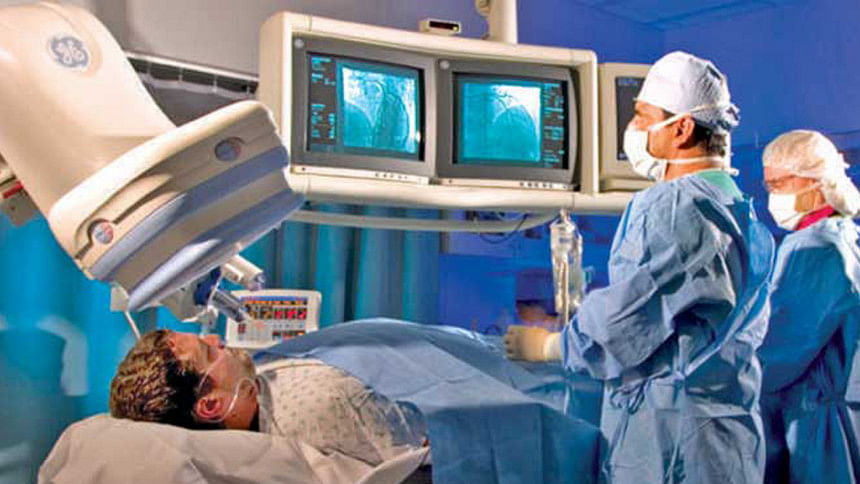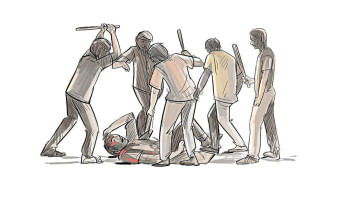Second Life: A Miracle of advanced Medical Science

It was on the second night that Shahana's husband thought he was signing the death warrant of his wife when he was asked to sign a form granting permission to try a drug, a last resort to bring her back. She was sedated with ventilator support at the neuro-ICU of a leading private hospital of the country. In her late forties, Shahana had had a stroke. At first she had been taken to a government neurological institution reputed to have the best neurological doctors of the country. But when the seizures did not stop and there was no doctor to attend her one Friday when she had yet another seizure, her relatives realised they had to take her somewhere else. They took her to the private hospital on Panthapath.
A lively, working woman, Shahana was now partially paralysed and continued to have seizures. She was given sedatives and placed under a ventilator because her seizures could not be stopped. According to the MRI and CT Scan reports at that hospital, blood was spreading all over her brain; she had already developed a massive clot of 22 centimetres in her brain. It was clear that her life was hanging by a thin thread.
Even if she somehow survived, her family was mentally preparing themselves to bring back a crippled and bed-ridden Shahana—not the fun-loving, boisterous, workaholic that everyone knew.
The hospital brought in a doctor from Vellor, the Indian city famous for medical excellence. The doctor explained to the family that there was nothing much for science to do, except let the bleeding stop naturally. The doctor from Vellor added that only in Japan and Germany could such patients get more advanced treatment.
On the second night, the doctors sought the family's consent to treat an unconscious Shahana with Heparin—a blood thinning drug that could remove her brain clots and thus save her; but also risked further bleeding inside her brain and kill her. "At this point, the doctors said this is the only option of treatment," notes her husband.
The Heparin did not kill her and the seizures seemed to have stopped. When the doctors tried to check her reflex by waking her up, her seizures returned. Shahana was sedated once again. The family was told to wait and see.
A man sitting at the neuro-ICU in that hospital told The Daily Star that his brother was at the ICU for more than two months. They had sold off their property to keep on treating him as they did not have the heart to pull the plug.
The ICU was charging a little more than Tk 1 lakh a day.
Meanwhile, Shahana's friends and family decided to try their luck treating her elsewhere—outside Bangladesh. Some questioned the point of sending her when there was no better treatment, while others agreed that it was worth taking a chance to find a new treatment. She was already in critical condition. There was nothing to lose.
On the night of July 22, they sent Shahana to Delhi, by air ambulance of Arirang Aviation—as the treatment cost was within their range. Shahana's friends gathered that there was a Dr Shakir— who had a reputation of being an extraordinary neurosurgeon.
During the flying hours, Shahana was still under sedatives with two drug pumps and oxygen giving her life support.
Sending such a patient to Delhi was very difficult because of various bureaucratic hurdles in obtaining clearance. When the aircraft landed at Delhi airport that night, there was no ambulance with life support at the tarmac because the Indian civil aviation had not given it a clearance; or there was some sort of miscommunication. They were offering an ordinary ambulance.
While the pilot of the aircraft and the patient's husband pleaded and argued with the airport officials, Shahana's friends from Dhaka also contacted high officials in Delhi over the phone to let an ambulance with life support enter the tarmac.
After a gruelling two hours, Shahana's oxygen monitor had gone red. The battery of her life support monitor had died. The syringe pumps did not have any medicine. Her caretakers in the aircraft were on the verge of losing their minds, berating themselves: why did we bring her here to die like this. It was at that cliff-hanger moment that the airport authorities let an ambulance with life support enter.
Within the next one hour, Shahana was admitted to the Saket City Hospital under Dr Shakir Husain.
Next morning, Dr Shakir's team embarked on a seven-hour long angiogram inside Shahana's brain. The angiogram wire was inserted into her vein and with help of visuals of her brain, the doctor painstakingly cleaned all the blood clots spread around her brain—except for a part in the central region—through the wire. A clot in the central part of brain had completely dried which could not be removed through this method. So the doctors administered a powerful drug to clean the clot.
When the team came out from the operation theatre declaring the operation to be successful, Shahana's husband could not believe it. "This man is an angel," he spontaneously reacted to his friends, "I thought it was a lost case. I can't believe how he turned it all around."
For Shahana, the anxiety was not yet over. Over the next few days, the doctors observed how she was recovering. Her initial recovery was not very encouraging, although she had opened her eyes and responded to her husband with gestures. Her husband, still recovering from the disbelief, was still doubtful that Shahana would actually walk back home as Dr Shakir was suggesting. What about the paralysis? What about her memories?
And then she gradually came out of the ventilator. She started talking. And when she did, to the surprise of all attendants, she did not forget her usual wry sense of humour. She even talked to her friends in Dhaka saying, "The doctor has told me that I am young again."
And then she gradually stood up with support. The hospital provided therapy and she started taking the first few steps with support. It seemed that she was no longer paralysed; and also, if she had lost any memory—it did not show.
Shahana returned home finally in mid-August; spending her Eid in Delhi in the hospital. She had a long list of follow ups, new diet rules and precautions for the rest of her life.
And how much did she have to pay for her treatment in Delhi? It was less than Tk 45000 a day on average.
The top hospital in Dhaka may be the most expensive in the country but it has failed to serve the real purpose of its existence - to save the lives of its patients not rob their bank accounts. It was also amazing that the hospital at Panthapath has a neuro-physician from Vellor who did not know that there were better treatment options in his homeland in India.
Dr Shakir's hospital charges less but offers the real deal. What's more—he stands way taller than the big names in Bangladesh because he visits Dhaka three to four times a year with his own money, bringing in the angiogram technology to the doctors in Dhaka and treating patients himself as many as he can.
Shahana has truly started her second life. To people who did not believe in the miracle of medical science and hands of a good doctor, Shahana's case is a prime example. Today Shahana not only walks, talks and socialises—she also attends her office in full swing and depends on no one for her daily chores.

 For all latest news, follow The Daily Star's Google News channel.
For all latest news, follow The Daily Star's Google News channel. 




Comments